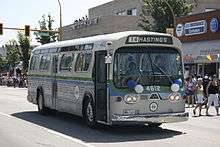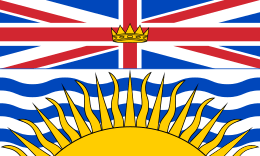BC Transit
BC Transit is a provincial crown corporation responsible for coordinating the delivery of public transportation within British Columbia, Canada, outside Greater Vancouver. BC Transit is headquartered in Victoria, British Columbia.
| Founded | 1983 |
|---|---|
| Headquarters | 520 Gorge Road East Victoria, British Columbia V8W 9T5 |
| Locale | Province of British Columbia (except Greater Vancouver) |
| Service area | 130 communities |
| Service type | bus service, paratransit, transportation planning |
| Fleet | 1079 vehicles<[1] |
| Annual ridership | 54,114,000 (2017/2018)[1] |
BC Transit is the successor to the British Columbia Electric Railway, which started in 1897 and in 1961 became a division of BC Hydro.[2] In 1979, the province separated the transit authority into a separate agency called the Urban Transit Authority which was later restructured into BC Transit in 1983.[3]
BC Transit carries out overall planning and delivery for all of the different municipal transit systems in British Columbia. In 1999, responsibility for the management of transportation in Greater Vancouver, including public transit, was taken over by the newly-formed TransLink. In the future, TransLink's jurisdiction is planned to expand into adjacent regions east and north of Greater Vancouver. (see TransLink 2007 reorganization)
History


The BC Electric Railway was incorporated in 1897 to take over the property and business of the Consolidated Railway Company. The Consolidated Railway Company had been formed the previous year, taking over ten other companies engaged in electric light systems or tramways in Vancouver, Victoria and New Westminster. Slowly the streetcars and interurban trams were converted to trolley and gas-powered buses. The province formed the British Columbia Hydro and Power Authority in 1962, bringing the transit systems under BC Hydro.[2]

In 1979 the province's Livable Region Plan led to the transfer of transit responsibilities to three agencies: the Greater Vancouver Regional District was to be responsible for transit policy and planning; the Urban Transit Authority, to represent provincial government interests in public transit; and the Metro Transit Operating Company, a separate crown corporation that took over operations from BC Hydro.[4] The new structure was meant to provide local governments with more decision-making power and funding of their local systems.[3]
BC Transit was created when, in 1982, the province merged the UTA and MTOC. The GVRD no longer had a role, and regional transit commissions were created in Vancouver and Victoria. The new regional commissions were tasked with approving local tariffs, planning, and some funding.[4]
In 1999, the responsibility for the transit system in Greater Vancouver was reassigned to TransLink, which had been founded a year earlier. The rest of BC remains under BC Transit.
In 2018, BC Transit began the operation of its first dedicated intercity buses in Northern British Columbia after Greyhound Canada ended all services in Western Canada. This was in the form of BC Bus North.[5]
In 2019, to address rising concerns of driver safety, the installation of driver safety doors on all buses began. The first bus with this modification was in Victoria.[6] In the same year, during the coronavirus outbreak, BC Transit went to a province-wide free-fare operation and required boarding through the rear door of buses with multiple doors.[7]
Transit systems

The Victoria Regional Transit System, in the provincial capital of Victoria, is the only system operated by BC Transit itself. Beyond Victoria, there are regional transit systems.[8] In four locations (Nanaimo, Nelson, Powell River, and the Sunshine Coast) the municipality operates the service, while private operators are contracted to deliver the transit services elsewhere.
Regional transit systems
- 100 Mile House
- Agassiz-Harrison
- Ashcroft-Cache Creek-Clinton
- Bella Coola
- Boundary
- Burns Lake
- Campbell River
- Central Fraser Valley
- Chilliwack
- Clearwater
- Columbia Valley
- Comox Valley
- Cowichan Valley
- Cranbrook
- Creston Valley
- Dawson Creek
- Elk Valley
- Fort St John
- Hazeltons
- Kamloops
- Kelowna
- Kimberley
- Kitimat
- Merritt
- Mount Waddington
- Nanaimo
- Pemberton Valley
- Penticton and Okanagan-Similkameen
- Port Alberni
- Port Edward
- Powell River
- Prince George
- Prince Rupert
- Princeton
- Quesnel
- Revelstoke
- Salt Spring Island
- Shuswap
- Skeena
- Smithers
- South Okanagan-Similkameen
- Squamish
- Summerland
- Sunshine Coast
- Terrace
- Vernon
- Victoria
- West Kootenay
- Whistler
- Williams Lake
Future systems
The Alberni-Clayoquot Regional District announced in 2017 that it was studying the feasibility of public transit connecting Tofino and Ucluelet. Feasibility studies concluded in November 2019,[9] with approval from the ACRD provided in late December 2019.[10] BC Transit began their first tests of the routes in February 2020.
HandyDART
HandyDART is an accessible transit service in British Columbia that uses vans or small buses to transport disabled or elderly passengers who cannot use the normal transit system.[11] This service provides door-to-door service and is available in all of the province's larger centres, as well as in many smaller communities. There are 16 custom accessible transit systems.[8]
BC BusNorth
BC Transit operates a limited intercity service with a hub in Prince George, serving as a replacement to connections lost when Greyhound left Western Canada.[12] While it bears no BC Transit markings and, it receives a large subsidy for operation and its scheduling, routing, and organization is guided by BC Transit.
Health Connections
BC Transit operates small interregional buses on infrequent schedules to primarily serve patients in rural areas needing access to urban centres, but makes the service available to all members of the public. The Health Connections network focuses on the Cariboo, Fraser Canyon, South Okanagan, Columbia and West Kootenays. These services, while scheduled, are not listed in standard riders guides as published by local agencies.
References
- "BC Transit 2017/2018 Annual Service Report" (PDF). BCBudget. Government of British Columbia. Retrieved 24 September 2019.
- "British Columbia Electric Railway Company". Archives. City of Vancouver. Retrieved 9 August 2014.
- "BC Transit - Our History". BCTransit.com. Retrieved 23 May 2020.
- "TransLink Governance Review - Appendix 1: TransLink Governance History" (PDF). TransLink.ca. Retrieved 16 November 2015.
- Little, Simon. "B.C. announces new northern bus service to replace Greyhound". Global News. Global News. Retrieved 23 September 2019.
- Taylor, Evan (October 3, 2019). "BC Transit starts outfitting buses in Greater Victoria with doors to improve driver safety". Goldstream Gazette. Black Press. Retrieved 5 October 2019.
- "BC Transit offers free rides and rear door loading". Prince George Citizen. Retrieved 2020-03-25.
- "BC Transit - Regional Transit System". Archived from the original on 2015-02-06. Retrieved 2015-02-06.
- Williams, Rob. "West Coast Transit System Project". Alberni-Clayoquot Regional District. ACRD.
- Bailey, Andrew. "ACRD approves BC Transit plan for Tofino-Ucluelet". Tofino-Ucluelet Westerly News. Black Press. Retrieved 20 January 2020.
- "HandyDART". Accessible Transit. TransLink. Retrieved 20 January 2016.
- Little, Simon (29 May 2019). "B.C. announces new northern bus service to replace Greyhound". Global News. Retrieved 24 September 2019.
